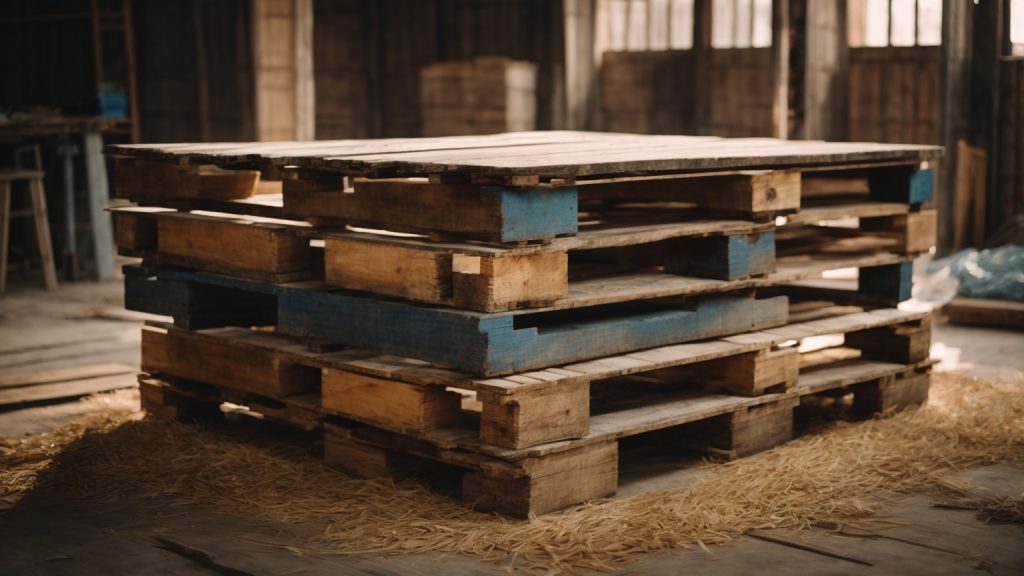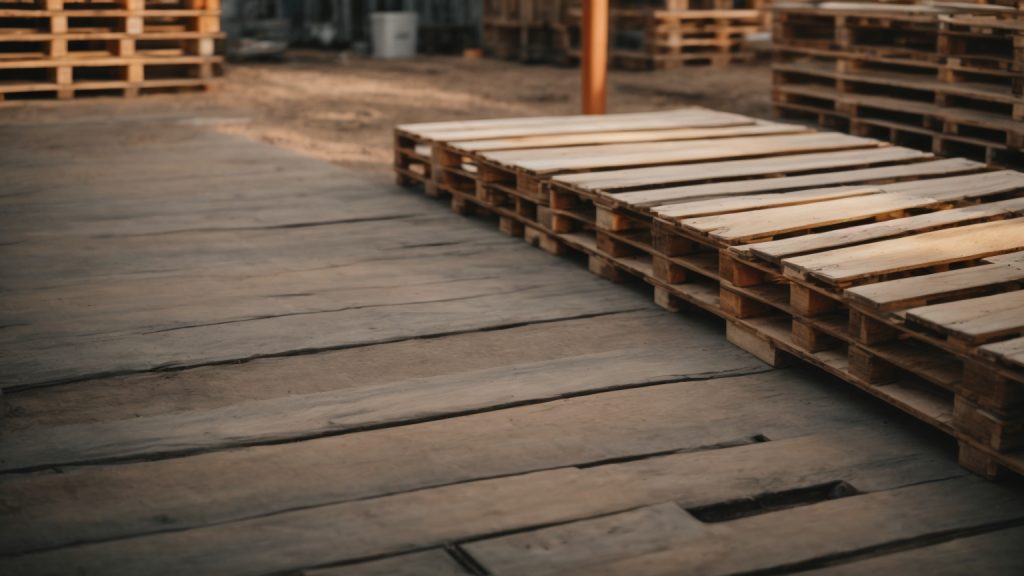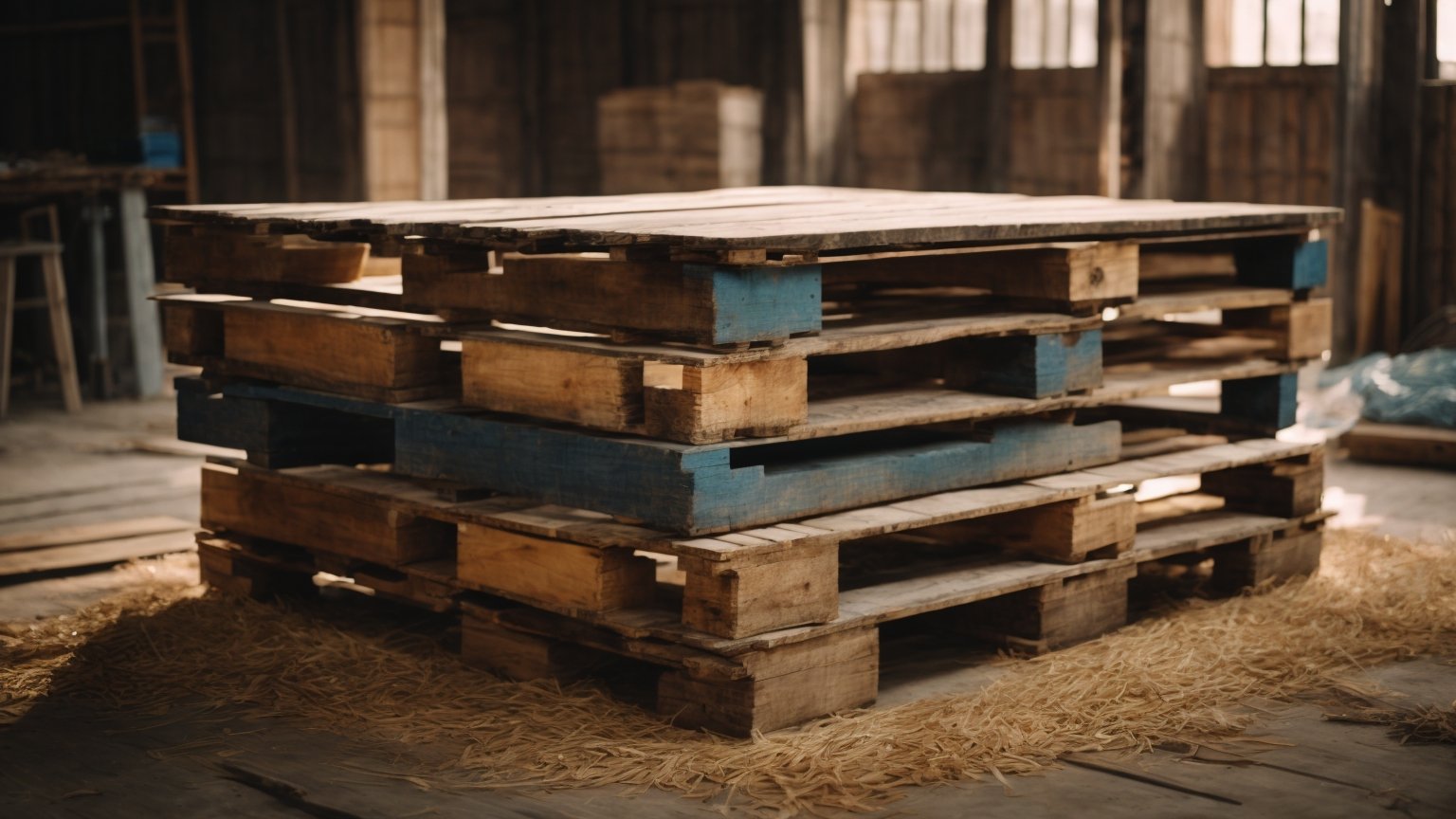Do you have a pile of wooden pallets taking up space in your yard or warehouse? Getting rid of them can seem like a daunting task, but it doesn’t have to be. With a little effort and creativity, you can dispose of your pallets in an eco-friendly and cost-effective way.
One option is to recycle them. Many local recycling centers accept wood pallets, so you can drop them off and give them a second life. This not only keeps them out of the landfill but also reduces the demand for new trees to be cut down for pallet production.
Another option is to sell them. Even if your pallets are in less-than-perfect condition, they can still fetch a competitive price. Some companies even offer pick-up services, making it easy to clear out your space quickly. Before pricing your pallets, consider factors such as their condition and the current market demand.
Understanding Wooden Pallets

If you work in a warehouse, construction site, or any industry that involves shipping and receiving goods, you are likely familiar with wooden pallets. Wooden pallets are a popular choice for transporting goods due to their durability and affordability. In this section, we will discuss the basics of wooden pallets, including their construction, size, and weight capacity.
Construction
Wooden pallets are typically made from hardwood or softwood and consist of a top deck, bottom deck, and stringers. The top and bottom decks are the flat surfaces of the pallet, and the stringers are the long, narrow boards that run perpendicular to the deck boards. The stringers are what support the weight of the goods on the pallet and allow forklifts and pallet jacks to lift and move the pallet.
Size
The most common size for wooden pallets in the United States is 48 inches by 40 inches. However, there are many other sizes available, ranging from small pallets used for retail displays to large pallets used for industrial machinery. When disposing of wooden pallets, it is important to know the size of the pallets you have to ensure that you choose the appropriate disposal method.
Weight Capacity
The weight capacity of a wooden pallet depends on several factors, including the type of wood used, the construction of the pallet, and the size of the pallet. As a general rule, a standard 48-inch by 40-inch wooden pallet can hold up to 4,600 pounds. However, it is important to note that this weight capacity can vary depending on the specific pallet and the goods being transported.
In summary, wooden pallets are a common and essential part of many industries. Understanding the construction, size, and weight capacity of wooden pallets can help you choose the appropriate disposal method and ensure that your goods are transported safely and efficiently.
Why Get Rid of Wooden Pallets
If you have old wooden pallets lying around, you may wonder why you should bother getting rid of them. After all, they’re just pieces of wood, right? Well, there are actually several good reasons why you should dispose of your wooden pallets properly.
Safety Concerns
One of the most important reasons to get rid of wooden pallets is safety. Pallets that are damaged or in disrepair can be a hazard to anyone who comes into contact with them. Workers who pass unserviceable pallets stacked on their feet can trip and bump into them, causing injury. Untidy spaces can also be dangerous! If you leave pallets around, they can quickly turn into a danger.
Clutter Reduction
Another reason to get rid of wooden pallets is to reduce clutter. Pallets can take up a lot of space, and if you have too many of them, they can make your home or business look messy and disorganized. By getting rid of your old pallets, you can free up space and create a more organized and efficient environment.
Environmental Impact
Wooden pallets can also have a negative impact on the environment if they are not disposed of properly. If you throw your pallets in the trash, they will end up in a landfill where they will take up space and contribute to pollution. However, there are many ways you can choose to get rid of unwanted pallets. You can recycle them by yourself into several different products, including mulch (a layer of material applied to the surface of the soil), animal bedding, and biofuel.
Overall, there are several good reasons why you should get rid of your wooden pallets. By doing so, you can create a safer, more organized environment while also doing your part to protect the planet.
Preparation for Disposal
Before disposing of your wooden pallets, it’s important to take some time to prepare them properly. This will not only make the disposal process easier, but it can also help you identify any pallets that may be reusable or recyclable. Here are some steps you can take to prepare your wooden pallets for disposal.
Inspecting the Pallets
The first step in preparing your wooden pallets for disposal is to inspect them for damage or signs of wear and tear. Look for broken or missing boards, loose nails or screws, and any other damage that may make the pallets unsafe to use. If you find any damaged pallets, set them aside for disposal.
Next, check the condition of the wood itself. If the wood is rotting or infested with insects, it may not be suitable for reuse or recycling. In this case, it’s best to dispose of the pallets.
Sorting the Pallets
Once you’ve inspected your pallets, sort them into three categories: reusable, recyclable, and disposable. Reusable pallets are those that are in good condition and can be used again. Recyclable pallets are those that can be broken down and the wood reused. Disposable pallets are those that are damaged or otherwise unsuitable for reuse or recycling.
If you have reusable pallets, consider donating them to a local school or nonprofit organization. These organizations often use pallets for various projects and can put them to good use without having to purchase new lumber.
Recyclable pallets can be taken to a local recycling center or sold to wood recyclers. Some companies may even offer pick-up services for pallets, which can help clear jobsites, warehouses, and driveways quickly.
Finally, dispose of any damaged or unsuitable pallets according to your local regulations. This may involve taking them to a landfill or arranging for a special pickup service. Be sure to follow all safety guidelines when handling and disposing of wooden pallets.
Methods of Disposal

When it comes to getting rid of wooden pallets, there are several methods of disposal you can choose from. Here are a few options to consider:
Recycling
Recycling is one of the most popular methods of disposing of wooden pallets. If you have a local recycling center that accepts wood, you can take your wood pallets there. This is a great way to give them a second life and keep them out of the landfill. You can also check with local businesses and see if they have a recycling program in place.
Selling
Regardless of condition, pallets can be sold for competitive prices. The average price for wood pallets in like-new or good condition is $0.50 – $4 per pallet. Some companies may offer pick-up services — which can help clear jobsites, warehouses, and driveways quickly. Consider these factors when pricing your pallets:
- Condition: Like-new pallets will fetch a higher price than damaged ones.
- Size: Larger pallets will generally command a higher price than smaller ones.
- Quantity: The more pallets you have to sell, the better the price you can negotiate.
Donating
If you have wooden pallets that are still in good condition, consider donating them to a local charity or non-profit organization. Many organizations use pallets to build structures or create furniture, so your donation could be put to good use.
Repurposing
Another option for getting rid of wooden pallets is to repurpose them. Pallets can be used to create a wide variety of items, including:
- Furniture: Pallets can be disassembled and used to create chairs, tables, and other pieces of furniture.
- Garden beds: Pallets can be used to create raised garden beds for growing vegetables and herbs.
- Art projects: Pallets can be used to create unique and interesting art projects, such as wall hangings or picture frames.
In conclusion, there are several methods of disposing of wooden pallets, including recycling, selling, donating, and repurposing. Choose the method that works best for you and helps keep these useful items out of the landfill.
Safety Precautions
When it comes to disposing of wooden pallets, it’s important to take some safety precautions to avoid any accidents or injuries. Here are some tips to keep in mind:
1. Wear Protective Gear
Before you start breaking down or moving wooden pallets, make sure to wear the appropriate protective gear. This includes gloves, safety glasses, and sturdy shoes to protect your hands, eyes, and feet from any potential hazards.
2. Use Proper Tools
Using the right tools can make the process of breaking down wooden pallets much easier and safer. A pallet buster or pry bar can help you remove the boards without causing damage to the wood. Avoid using tools that are dull, rusty, or damaged, as they can be dangerous to use.
3. Watch Your Surroundings
When working with wooden pallets, it’s important to be aware of your surroundings. Make sure you have enough space to move around and avoid working in areas with high foot traffic. Keep an eye out for any potential hazards, such as uneven surfaces or sharp objects.
4. Lift with Proper Technique
Moving wooden pallets can be heavy and awkward, so it’s important to use proper lifting technique to avoid strain or injury. Bend your knees and lift with your legs, rather than your back. If possible, use a dolly or hand truck to help you move the pallets.
5. Dispose of Pallets Properly
Finally, make sure to dispose of wooden pallets properly. Avoid leaving them lying around where they can cause a tripping hazard, and don’t burn them, as this can release harmful chemicals into the air. Instead, consider recycling or repurposing the pallets, or contact a waste management company to properly dispose of them.
By following these safety precautions, you can safely and effectively dispose of wooden pallets without putting yourself or others at risk.
Local Laws and Regulations
When it comes to getting rid of wooden pallets, it’s important to be aware of local laws and regulations. Depending on where you live, there may be specific rules and guidelines that dictate how you can dispose of your pallets. Failing to follow these regulations can result in fines or other penalties, so it’s important to do your research before getting rid of your pallets.
One common regulation that you may encounter is a ban on burning wooden pallets. Burning pallets can release harmful chemicals into the air, which can be harmful to both the environment and human health. If burning is not allowed in your area, you will need to find an alternative method for disposing of your pallets.
Another regulation to be aware of is the requirement to properly label and package pallets for disposal. This may involve using specific types of containers or marking pallets with identifying information. Failure to properly label and package your pallets can result in fines or other penalties.
In addition to these regulations, you may also need to obtain permits or licenses to dispose of your pallets. This is especially true if you are disposing of large quantities of pallets or if you are using a commercial disposal service. Be sure to check with your local government or waste management authority to determine what permits or licenses you may need.
Overall, it’s important to be aware of local laws and regulations when getting rid of wooden pallets. By doing your research and following the rules, you can ensure that you dispose of your pallets safely and responsibly.
